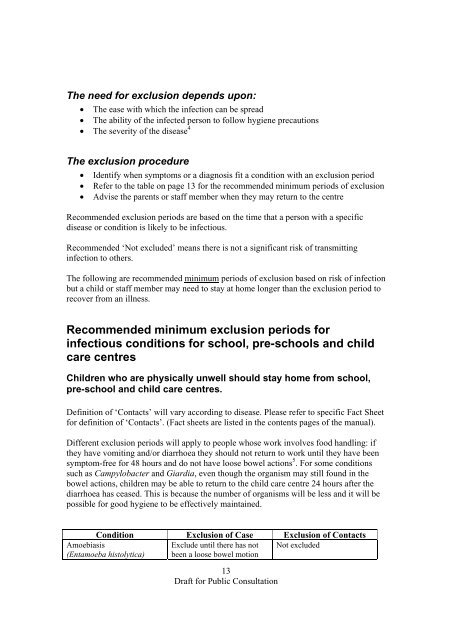Staying Healthy in Child Care - National Health and Medical ...
Staying Healthy in Child Care - National Health and Medical ...
Staying Healthy in Child Care - National Health and Medical ...
Create successful ePaper yourself
Turn your PDF publications into a flip-book with our unique Google optimized e-Paper software.
The need for exclusion depends upon:<br />
• The ease with which the <strong>in</strong>fection can be spread<br />
• The ability of the <strong>in</strong>fected person to follow hygiene precautions<br />
• The severity of the disease 4<br />
The exclusion procedure<br />
• Identify when symptoms or a diagnosis fit a condition with an exclusion period<br />
• Refer to the table on page 13 for the recommended m<strong>in</strong>imum periods of exclusion<br />
• Advise the parents or staff member when they may return to the centre<br />
Recommended exclusion periods are based on the time that a person with a specific<br />
disease or condition is likely to be <strong>in</strong>fectious.<br />
Recommended ‘Not excluded’ means there is not a significant risk of transmitt<strong>in</strong>g<br />
<strong>in</strong>fection to others.<br />
The follow<strong>in</strong>g are recommended m<strong>in</strong>imum periods of exclusion based on risk of <strong>in</strong>fection<br />
but a child or staff member may need to stay at home longer than the exclusion period to<br />
recover from an illness.<br />
Recommended m<strong>in</strong>imum exclusion periods for<br />
<strong>in</strong>fectious conditions for school, pre-schools <strong>and</strong> child<br />
care centres<br />
<strong>Child</strong>ren who are physically unwell should stay home from school,<br />
pre-school <strong>and</strong> child care centres.<br />
Def<strong>in</strong>ition of ‘Contacts’ will vary accord<strong>in</strong>g to disease. Please refer to specific Fact Sheet<br />
for def<strong>in</strong>ition of ‘Contacts’. (Fact sheets are listed <strong>in</strong> the contents pages of the manual).<br />
Different exclusion periods will apply to people whose work <strong>in</strong>volves food h<strong>and</strong>l<strong>in</strong>g: if<br />
they have vomit<strong>in</strong>g <strong>and</strong>/or diarrhoea they should not return to work until they have been<br />
symptom-free for 48 hours <strong>and</strong> do not have loose bowel actions 5 . For some conditions<br />
such as Campylobacter <strong>and</strong> Giardia, even though the organism may still found <strong>in</strong> the<br />
bowel actions, children may be able to return to the child care centre 24 hours after the<br />
diarrhoea has ceased. This is because the number of organisms will be less <strong>and</strong> it will be<br />
possible for good hygiene to be effectively ma<strong>in</strong>ta<strong>in</strong>ed.<br />
Condition Exclusion of Case Exclusion of Contacts<br />
Amoebiasis<br />
Exclude until there has not Not excluded<br />
(Entamoeba histolytica) been a loose bowel motion<br />
13<br />
Draft for Public Consultation
















